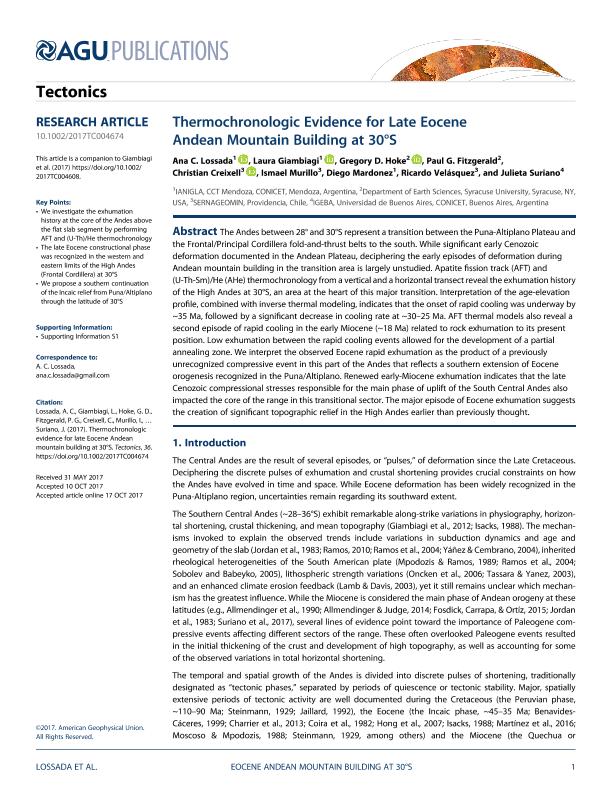Mostrar el registro sencillo del ítem
dc.contributor.author
Lossada, Ana Clara

dc.contributor.author
Giambiagi, Laura Beatriz

dc.contributor.author
Hoke, Gregory D.

dc.contributor.author
Fitzgerald, Paul G.
dc.contributor.author
Creixell, Christian
dc.contributor.author
Murillo, Ismael
dc.contributor.author
Mardonez Catalán, Diego José

dc.contributor.author
Velásquez, Ricardo
dc.contributor.author
Suriano, Julieta

dc.date.available
2018-08-27T21:16:19Z
dc.date.issued
2017-11
dc.identifier.citation
Lossada, Ana Clara; Giambiagi, Laura Beatriz; Hoke, Gregory D.; Fitzgerald, Paul G.; Creixell, Christian; et al.; Thermochronologic Evidence for Late Eocene Andean Mountain Building at 30°S; American Geophysical Union; Tectonics; 36; 11; 11-2017; 2693-2713
dc.identifier.issn
0278-7407
dc.identifier.uri
http://hdl.handle.net/11336/57317
dc.description.abstract
The Andes between 28° and 30°S represent a transition between the Puna-Altiplano Plateau and the Frontal/Principal Cordillera fold-and-thrust belts to the south. While significant early Cenozoic deformation documented in the Andean Plateau, deciphering the early episodes of deformation during Andean mountain building in the transition area is largely unstudied. Apatite fission track (AFT) and (U-Th-Sm)/He (AHe) thermochronology from a vertical and a horizontal transect reveal the exhumation history of the High Andes at 30°S, an area at the heart of this major transition. Interpretation of the age-elevation profile, combined with inverse thermal modeling, indicates that the onset of rapid cooling was underway by ~35 Ma, followed by a significant decrease in cooling rate at ~30–25 Ma. AFT thermal models also reveal a second episode of rapid cooling in the early Miocene (~18 Ma) related to rock exhumation to its present position. Low exhumation between the rapid cooling events allowed for the development of a partial annealing zone. We interpret the observed Eocene rapid exhumation as the product of a previously unrecognized compressive event in this part of the Andes that reflects a southern extension of Eocene orogenesis recognized in the Puna/Altiplano. Renewed early-Miocene exhumation indicates that the late Cenozoic compressional stresses responsible for the main phase of uplift of the South Central Andes also impacted the core of the range in this transitional sector. The major episode of Eocene exhumation suggests the creation of significant topographic relief in the High Andes earlier than previously thought.
dc.format
application/pdf
dc.language.iso
eng
dc.publisher
American Geophysical Union

dc.rights
info:eu-repo/semantics/openAccess
dc.rights.uri
https://creativecommons.org/licenses/by-nc-sa/2.5/ar/
dc.subject
Eocene Constructional Phase
dc.subject
Exhumation
dc.subject
Mountain Building
dc.subject
South Central Andes
dc.subject
Thermochronology
dc.subject.classification
Meteorología y Ciencias Atmosféricas

dc.subject.classification
Ciencias de la Tierra y relacionadas con el Medio Ambiente

dc.subject.classification
CIENCIAS NATURALES Y EXACTAS

dc.title
Thermochronologic Evidence for Late Eocene Andean Mountain Building at 30°S
dc.type
info:eu-repo/semantics/article
dc.type
info:ar-repo/semantics/artículo
dc.type
info:eu-repo/semantics/publishedVersion
dc.date.updated
2018-08-21T19:11:05Z
dc.journal.volume
36
dc.journal.number
11
dc.journal.pagination
2693-2713
dc.journal.pais
Estados Unidos

dc.description.fil
Fil: Lossada, Ana Clara. Consejo Nacional de Investigaciones Científicas y Técnicas. Centro Científico Tecnológico Conicet - Mendoza. Instituto Argentino de Nivología, Glaciología y Ciencias Ambientales. Provincia de Mendoza. Instituto Argentino de Nivología, Glaciología y Ciencias Ambientales. Universidad Nacional de Cuyo. Instituto Argentino de Nivología, Glaciología y Ciencias Ambientales; Argentina
dc.description.fil
Fil: Giambiagi, Laura Beatriz. Consejo Nacional de Investigaciones Científicas y Técnicas. Centro Científico Tecnológico Conicet - Mendoza. Instituto Argentino de Nivología, Glaciología y Ciencias Ambientales. Provincia de Mendoza. Instituto Argentino de Nivología, Glaciología y Ciencias Ambientales. Universidad Nacional de Cuyo. Instituto Argentino de Nivología, Glaciología y Ciencias Ambientales; Argentina
dc.description.fil
Fil: Hoke, Gregory D.. Syracuse University; Estados Unidos
dc.description.fil
Fil: Fitzgerald, Paul G.. Syracuse University; Estados Unidos
dc.description.fil
Fil: Creixell, Christian. Servicio Nacional de Geología y Minería; Chile
dc.description.fil
Fil: Murillo, Ismael. Servicio Nacional de Geología y Minería; Chile
dc.description.fil
Fil: Mardonez Catalán, Diego José. Consejo Nacional de Investigaciones Científicas y Técnicas. Centro Científico Tecnológico Conicet - Mendoza. Instituto Argentino de Nivología, Glaciología y Ciencias Ambientales. Provincia de Mendoza. Instituto Argentino de Nivología, Glaciología y Ciencias Ambientales. Universidad Nacional de Cuyo. Instituto Argentino de Nivología, Glaciología y Ciencias Ambientales; Argentina
dc.description.fil
Fil: Velásquez, Ricardo. Servicio Nacional de Geología y Minería; Chile
dc.description.fil
Fil: Suriano, Julieta. Consejo Nacional de Investigaciones Científicas y Técnicas. Oficina de Coordinación Administrativa Ciudad Universitaria. Instituto de Geociencias Básicas, Aplicadas y Ambientales de Buenos Aires. Universidad de Buenos Aires. Facultad de Ciencias Exactas y Naturales. Instituto de Geociencias Básicas, Aplicadas y Ambientales de Buenos Aires; Argentina
dc.journal.title
Tectonics

dc.relation.alternativeid
info:eu-repo/semantics/altIdentifier/doi/http://dx.doi.org/10.1002/2017TC004674
dc.relation.alternativeid
info:eu-repo/semantics/altIdentifier/url/https://agupubs.onlinelibrary.wiley.com/doi/abs/10.1002/2017TC004608
Archivos asociados
